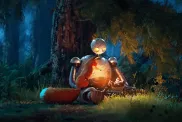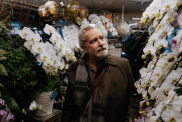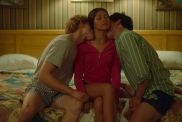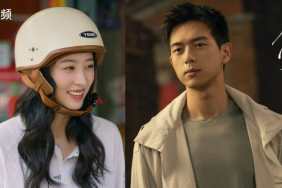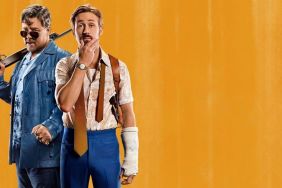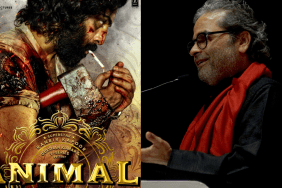The cast and crew on updating the ’85 film

To some of those staying at this Hard Rock Hotel & Casino in New Mexico, the giant banner hanging in the lobby, featuring a lithe, raven-haired illusionist sprouting blue lightning from his palms, is just another advertisement for a stage performer. Guests enter, cocking their heads curiously before checking in at the front desk, perhaps wondering where they can see this gothic chap do his shtick. But to cinephiles or fans of horror films, particularly of the vampire variety, seeing the banner’s bold print, the name Peter Vincent and his show, entitled “Fright Night,” will ring a bell, even if the illusionist’s visage on the banner does not.
The ad is a piece of décor left behind from a previous day’s shoot on the set of Fright Night, a re-imagining of Tom Holland’s 1985 film of the same name. But when Shock shows up for a visit, the banner is in the process of coming down. Shooting at the Hard Rock has moved from the lobby and into a nightclub adjacent to the lobby. Inside, Charley Brewster and his girlfriend Amy (Star Trek‘s Anton Yelchin and 28 Weeks Later‘s Imogen Poots) are attempting to flee from Charley’s neighbor Jerry Dandrige (Colin Farrell). The bustling crowd of extras and table dancers only momentarily help camouflage the teenagers until Jerry sees them and cuts his way through the throbbing mass of bodies.
Director Craig (Lars and the Real Girl) Gillespie’s camera tracks Jerry and tilts its lens to the mirrored ceiling where the crowd around him seems to part by some invisible forceâ¦but he casts no reflection. Because Jerry is a vampire.
The road to this latest Hollywood remake has been a somewhat long one, although producer Mike De Luca will tell you that it was set up and developed relatively fast once the property landed at DreamWorks. In its early stages, the Fright Night redo languished at Sony where its genre outfit, Screen Gems, took a crack at the material. There, execs considered simply using the title for a horror story set at an amusement park. Ultimately, the rights went to DreamWorks and Marti Noxon (Buffy the Vampire Slayer) was hired to re-tell the story of a teenage boy named Charley who discovers a vampire has moved in next door to his house. In a classic “the boy who cried wolf” tradition, no one believes Charley, not even the local vampire expert Peter Vincent, so he takes it upon himself to stake the creature of the night.
Says De Luca, “Marti’s pitch and her script were really galvanizing, it’s true. Steven [Spielberg] loved it and everybody goes “Oh my God, Steven loved it at DreamWorks.” Immediately when that response comes in, all the gates open and the angels come down and the trumpets blare, flowers grow, and we’re all off to the races.”
But how much of Fright Night is reinvented for 2011? De Luca says it’s “25% from original, 75% new. And most of original has to do with the premise obviously, and certain scenes are straight up homages that are in the movie. But, I’d say it’s like that kind of ratio.”
For more, we turn to Noxon, Gillespie, his cast and KNB EFX’s Howard Berger.
Question: How do you carry the heart of the original Fright Night into a new generation?
Marti Noxon: It’s funny because I would say that would be the heart of why I got the job. Because I think other people had come in and talked about vampires and I had come in and talked about the relationship between Ed and Charlie and also about the relationship between him and Amy, Charlie and Amy and his mom and I was much more interested in the stuff that I had always felt like I wanted some filling in on in the original movie. I had a lot of questions. I loved the original movie for just that reason. And certainly my training on “Buffy” was all about character. And, what’s the story you’re telling? What’s the theme? What’s the relatable thing for the audience? I felt like there were a lot of seeds in the original movie that hadn’t been fully exploited.
Question: Can you talk a little about some of the changes that were made? For example, Peter Vincent’s no longer a horror host.
Noxon: Again, it’s many years [after the original film], and the people who were watching that movie had a very strong point of reference for Peter Vincent being a TV horror movie host. There are few still out there but it’s few and far in between. I was really inspired by the idea that Penn and Teller have this amazing supernatural collection. And I was like, well, who can be a real asset? It has to be set in Vegas, specifically because I have been thinking about that for a long time, having spent some time there. I was out in Park County and these various places, and I was like, where better for a demon to hide out than in Vegas? It’s a transient population, people sleep all day and party all night and nobody would notice if people just went missing. I’d already been thinking about Vegas and it was a natural [fit].

Question: How do the vampires differ from everything we’ve seen before?
Noxon: I had a specific take on it. And of course the people who designed the creatures and the look then took that and expanded it. You know it’s hard because everything has been done and one of the great things about the original movie was how great some of that design was. I think we sort of modernized that, I don’t think we tried to create an entirely new vampire. But we definitely had a theme for the vampire. One of the first things that happened when I worked on the movie was they said, yeah, we’re just kind of thinking that this vampire is more like Jaws. You’ll see some sort of almost shark-like elements in the design.
Question: As a writer, how do you avoid the Buffy comparisons? How do you break Buffy-speak? Do you find yourself falling into writing the characters like that?
Noxon: Yes and no. I would say part of the reason why I survived the Buffy experience was because of the ear for that. It’s not nearly as stylized. It’s funny, I went back recently and watched some Buffy because I was doing some lecturing and I was like, wow! We were giving The Gilmore Girls a run for their money. And what’s so funny is that I was so critical of other people’s highly stylized dialogue because it’s so unreal. The goal in this one was I think to more create a language for the teenagers that felt authentic. And they’re more clever than I am for sure. It takes me longer to make up their dialogue than my own words.
Question: The original was a love letter to the vampire films that came before it â the Hammer era, the Universal monsters era. Does this new version show any reverence for vampire films of the last two decades or so?
Noxon: It’s interesting, I feel like I’ve come to a place where I feel like these movies, because audiences are so sophisticated, you almost try to keep all that to a total minimum. Like, don’t drag the story down with a lot of… it depends what kind of movie it is, but in this one in particular, it’s like let’s just get to it. We all know what vampires are, we all know what the rules are, we over-know it, you know what I mean? And the rules are so malleable now, with True Blood and Twilight, there’s a million different things you can be doing so… I felt like, let’s give as simple an explanation and then just get it to them.
Question: So, let’s talk about your incarnation of Jerryâ¦
Colin Farrell: I’m in trouble on the first question. [laughs[ I have no idea. We’re halfway through the film and the character’s design in this is the less romantic rendering of the vampire, as represented even in the original myth of “Dracula” with the Madam Mina figure that he’s searching the world for. In this one he’s more territorial. He’s got a large appetite, really. He’s just, as I say to Christopher Mintz-Plasse’s character in the film, yeah he’s not romantic. He’s not Edward Cullen, he’s not Dracula, he says he’s Jaws, he’s just f**king Jaws. He eats, he eats, then he moves on. In the film he’s four hundred years old, so I think he’s probably also a little bit bored, a little bit lonely but just doesn’t have those romantic illusions like the other characters have.
When I read the script, I was a fan of Fright Night. The original I probably saw when I was around nine or ten, and then the next time I saw it say around ten times when it went out in the next ten years. When I heard they were making a film I was like “F**king Hollywood,” impressively lacking originality once more. And then I read it and I was hoping I wouldn’t like it, but motherf**ker! Oh no! It read as the original, but obviously it’ll be completely contemporized, a new perspective on the story. But in essence, as a read it was too much fun so I just jumped at the chance.

With [Craig] Gillespie, he had a really distinct idea for heading onto the film. There’s one thing that I knew about Craig Gillespie that was he had an incredible ability to kind of grasp a specific tonality in a film. He had to tread the line between the lies and the real world, between the more absurd and comedic aspects of the story and the more touching, deeply human and painful aspects of that film.
It is fun, I’m having fun playing Jerry. The whole fun is imagining taking what initially what any fan loved about the original is there and just addressing it in a different way. I would hope that you would be a fan of the original. I would like to think that other fans of the original would like it. Having said that, I don’t know what the film’s like. Maybe I won’t f**king like it, who knows? It’s not whatever it is, thirty, forty, whatever it costs million dollar exercise in nostalgia. At the end of the day, it’s made for a new audience and there are some people who are attached to the original and let’s see if they like it best.
Question: I notice your using a crane in a really small location, is that what you’re doing for the rest of the film? Doing really cool shots?
Craig Gillespie: No, actually I got the idea for this from that U2 3D video, it was awesome with all these crane shots going over a crowd. We’re in a packed environment here so that’s where the quality looks great, so we’re doing it here. Also the 3D camera weighs about 85 pounds, so the crane kind of helps. We have a steadicam, but the steadicam operator gets pretty damn tired lugging that thing around, it’s usually 28 pounds for the camera. For 3D it’s always nice to have the camera moving and the background always changing so we do have the camera moving all the time. [To Anton] What do you think about that crane idea? [laughs]
Anton Yelchin: We’ll talk about it later.
Gillespie: He’s being nice, he wanted lock-offs.
Yelchin: No, it’s fine, I’ve gotten used to it.
Gillespie: He never knows where the eye line is.
Question: Can you guys talk about what attracted you to this project, what really appealed to you?
Yelchin: I read it and I thought it was really great and I wanted to work with Craig and I just thought it was really cool. It’s a very legitimate vampire story in the sense that the vampires are actually dangerous. They play the “monster” role as opposed to whatever it’s been recently. It’s a legitimate, frightening, destructive chaotic being that just wants to f**king kill everything, which is great! It sounds good to me, it’s something I’d want to see. I just think it’s a legitimate way to portray a monster. I think it’s interesting that Jerry – in addition to being destructive – sexually preys. In the original, especially, but this one as well. It’s not like he just destroys, there’s a complexity to the way he preys on people which I thought was really cool.
Question: Are there any differences between the original Charley and the Charley you’re embodying?
Gillespie: I think you’re using a Russian accent…
Yelchin: Yeah, I’m doing an accent. [laughs] No, I think they’re in similar situations, you know and there’s the same kind of desperation and then fear and then desire to survive that’s in the original one.
Gillespie: The thing that’s in Marty’s script, there are several genres going on here. She’s written some great character development in terms of the classic teenage angst and coming of age and turning into a man and just the choices you make going through your teenage years choosing between your friends and what defines you as a person. Charlie makes mistakes throughout the movie which he then pays for which is a whole subplot going on and that really invests you in those characters because you can relate to them. That’s part of what he has to do is come back over the bad choices he’s made throughout the film and sort of rectify those choices, and part of that is coming up against the vampires.
Yelchin: I think if you look at the vampires very simply as “Death” then that is what makes him realize what he values and what the people around him really mean to him when it all gets threatened. Basically, the vampires just destroy his reality. I think there’s more of that [in this movie] than in the last one. There’s less of an arc to Charley, he just freaks out then continues to freak out until he defeats Jerry. Whereas here, it’s just what Craig says: he really goes on a journey to become a person that is able to actually fight vampires.

The horror part of this wasn’t the tricky part for me, the tone of this is the hardest part. We’ve got some scenes that are just classic horror and I think they work great but there is that balance that we’re trying to get, which I guess is from the â80s where they try to mix comedy and drama and the thriller aspect like An American Werewolf in London and being able to make that change and do that shift. Being able to go to these scary moments and be invested in that but then still being able to have levity at times and then some really emotional moments, that was the tricky part, it’s not just one genre. It’s hard to find modern day examples of that, they did that more in the â80s.
Question: Craig we’re seeing you do a spin on a theme that we’ve seen many times before [in this shot] with the vampire not being able to appear in the mirror. Has it been challenging trying to re-imagine things like this, do you say, “Oh man, how am I going to put a new spin on this?”
Gillespie: Honestly I try to keep it as part of the storytelling and not try to make it a big event, there’s actually only two shots where he deals with the mirror. It’s actually been harder trying to keep him out of reflections, where we’ll see him like “Uh oh, we see him in the car window or we see him in a window in the background.” There will be a couple of other moments but really we just keep it part of the storytelling. Amy will see herself in the mirror and it will be very brief but I just try not to make a big moment out of it, just stay with the characters all the time.
Source: Ryan Turek, Managing Editor

